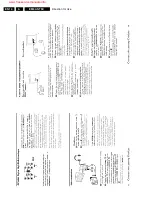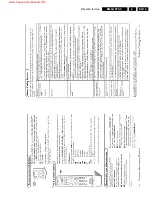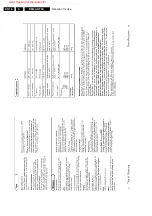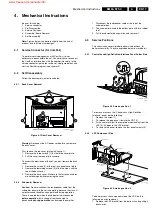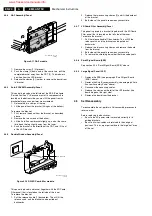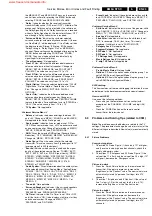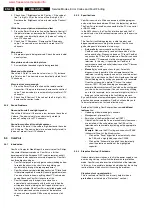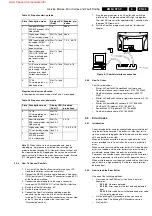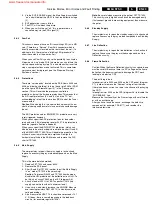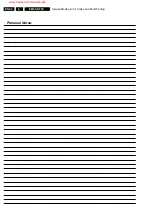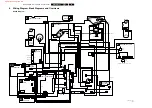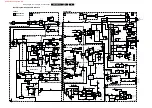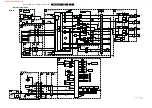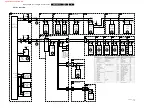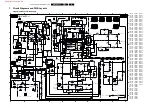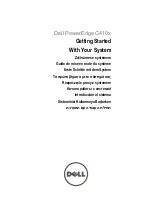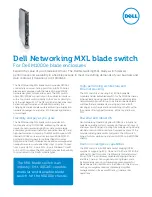
Service Modes, Error Codes and Fault Finding
EN 28
5.
again, to ensure normal picture and sound conditions of the
set.
8 V and 5 V protection: The microprocessor senses the
presence of the 8 V and 5 V (via the '+5V_CON' and
'+8V_CON' lines.) If one (or both) of these voltages is (are) not
present, an error code is stored in the error buffer of the NVM,
and the set is put in protection mode.
5.7.4
HOP Related Protections
Every 200 ms, the status register of the HOP is read by the
OTC (via the I
2
C bus.) If a protection signal is detected on one
of the inputs of the HOP, the relevant error bit in the HOP
register is set to “high”. If this error bit is still “high” after 1 s, the
OTC will store the error code in the error buffer of the NVM and,
depending on the relevancy of the error bit, the set may or may
not go into protection mode.
The following protections are implemented:
•
HFB (Horizontal Flyback): If the horizontal flyback is not
present, this is detected via the HOP (HFB_X-
RAY_PROT.) One status bit is set to “high”. The error code
is stored in the error buffer and the set will go into
protection mode.
•
XPR (X-ray protection): If the HFB pulses are too low
(level detection), the HOP will detect this via the XPR-bit.
The error will be logged in the error buffer and the set will
go into protection mode.
Note: Both errors will be logged as HFB-failure.
5.7.5
Hardware Related Protections
Due to the architecture (“hot” deflection), some protections
cannot be sensed by the microprocessor. Three of these
protections will lead to a protection on set level (“power-off”
mode and blinking LED), while another will only lead to a circuit
protection.
TV set Protection
The following fault conditions will lead to a “complete” set
protection:
•
BRIDGECOIL protection: This is sensed via the 'EW'
signal going to the base of TS7652 (via R3495 and D6499.)
In a normal situation, the voltage on C2498 (diagram A4) is
high and TS7652 is conducting. When bridge coil 5422
(diagram A3) is short circuited, the voltage on C2498
changes to low, which will block TS7652. In this case,
TS7641 will also block and the voltage on 2642 will rise
until TS7443 is forced in conduction. The 'SUP-ENABLE'
signal (-20 V in normal operating conditions) is now shorted
to ground level, which will force the Main Power Supply to
“power-off” mode.
•
ARC protection: If there are “open” connections (for
example, bad solder joints) in the high-energy deflection
circuitry, this can lead to damaging effects (fire.) For that
reason, the E/W current is sensed (via 3479/3480.) If this
current becomes too high, the “thyristor” circuit (TS7653
and TS7654) is triggered. TS7442 is switched “on” and
TS7443 is forced into conduction. The 'SUP-ENABLE'
signal is now shorted to ground level, which will force the
Main Power Supply to “power-off” mode.
•
NON_VFB (No vertical Flyback) protection: If the frame
stage generates no pulses, TS7641 will block. TS7443 is
now switched “on”, which will lead to “power-off” mode. So,
in normal operation conditions, TS7641 and TS7652 are
conducting, while TS7443 is blocked.
Circuit Protection
The following fault condition will lead to a “partial” set
protection:
•
PROT1 (DC) protection: When a DC voltage (positive or
negative) is sensed on one of the loudspeaker outputs, the
protection circuit (TS7704, 7705, 7706 and 7707 in
diagram A6) will put IC7700 in Standby mode (via tri-state
input pin 6.) For more details, see the 'Circuit Descriptions
and Abbreviation List' section.
5.8
Repair tips
5.8.1
Miscellaneous
The relay you hear when you switch the set “on”, is from the
degaussing circuitry. It is not used for switching the Power
Supply (as was the case in the MG chassis.)
Always switch the set completely 'off' (disconnect the AC
power cord) when you want to remove the SSB module,
otherwise a lot of components can be damaged (because there
always is a standby voltage present on the SIMM connector.)
Take care not to touch the “hot” heatsink while disconnecting
the SSB, despite the fact that the power cable is disconnected.
A rest-voltage can remain on the heatsink for a short while.
Advice: When you remove the SSB, disconnect the power
cable.
Do not try to measure on the SSB side, which is facing the
“hot” heatsink. This is dangerous. Most service test points are
on the “tuner” side and are indicated by the “service” printing.
Where the circuitry was too “crowded” for this printing, you can
find the correct location on the “test point overviews” in this
manual.
A very large portion of the LSP is “hot”, such as:
–
The primary part of the Standby Supply.
–
The whole Main supply (except for the secondary Audio
supply.)
–
The complete deflection circuitry (note that the deflection
coil is hot!)
5.8.2
Start-up Sequence
Figure 5-3 Start-up circuitry
The start up sequence differs from other sets (for example, MG
sets or EM2E sets; but it is the same as the EM3E set):
1.
When the set is switched “on”, the 5 V and 8 V lines
(‘+5V_CON’ and ‘+8V_CON’) of the standby power supply
are activated.
2.
After the OTC senses these voltages, the
µ
P will address
the HOP via the I
2
C-bus, to start the drive [1].
RESET
5VCON
8VCON
8V
29
I2C BUS
5
17/39
OUT
HOP
CUTOFF
(from
CRT panel)
START/STOP
START/STOP
COLD
EHT-INFO
HOT
7131
7141
5V
8V
+11D
OTC
POR
POR
7445
106
105
99
104
STANDBY
low 7131/41 closed
high 7131/41 open
220 VAC
STBY
SUPPLY
Vbat
SUP-ENABLE
MAIN
SUPPLY
PROT-
SENSING
LINE DEFL.
(BRIDGECOIL
-PROT)
(ARC-PROT)
FRAME
DEFL
(NON-VFB)
CL16532044_023.eps
140501
1
3
2
www.freeservicemanuals.info
Summary of Contents for EM5A NTSC
Page 6: ...Direction for Use EN 6 EM5A NTSC 3 3 Direction for Use www freeservicemanuals info ...
Page 7: ...Direction for Use EN 7 EM5A NTSC 3 www freeservicemanuals info ...
Page 8: ...Direction for Use EN 8 EM5A NTSC 3 www freeservicemanuals info ...
Page 9: ...Direction for Use EN 9 EM5A NTSC 3 www freeservicemanuals info ...
Page 10: ...Direction for Use EN 10 EM5A NTSC 3 www freeservicemanuals info ...
Page 11: ...Direction for Use EN 11 EM5A NTSC 3 www freeservicemanuals info ...
Page 12: ...Direction for Use EN 12 EM5A NTSC 3 www freeservicemanuals info ...
Page 13: ...Direction for Use EN 13 EM5A NTSC 3 www freeservicemanuals info ...
Page 14: ...Direction for Use EN 14 EM5A NTSC 3 www freeservicemanuals info ...
Page 15: ...Direction for Use EN 15 EM5A NTSC 3 www freeservicemanuals info ...
Page 16: ...Direction for Use EN 16 EM5A NTSC 3 www freeservicemanuals info ...

